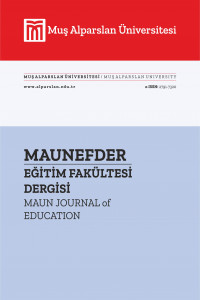Motivational Strategies in Language Learning: Student-Teachers’ Perceptions and Views
1.
2.
3. English as a
foreign language
4. Studentteachers’
motivational
strategies
Anahtar Kelimeler:
Motivation, Motivational strategies, Motivational strategies
Motivational Strategies in Language Learning: Student-Teachers’ Perceptions and Views
In English as a Foreign Language (EFL) context, students’ perceptions of teaching strategies
affect their motivation towards their language learning. These perceptions are influenced by
the context in which they learn. The study is a modified replication of Cheng and Dörnyei
(2007) to which it added interview as an extra data collection tool. This paper aims to
investigate student teachers’ perceptions and views of motivational strategies in the Turkish
educational context. To determine their perspectives, a questionnaire was administered to
103 student teachers studying at the department of English language teaching of a state
university. Thirteen volunteers were interviewed to identify their views on motivational
strategies. The results indicated that EFL student teachers in Turkey were aware of the
importance of motivational strategies. Furthermore, unique to this study, all the examined
strategies were highest-ranked relative to their perceived importance, indicating that
Turkish student teachers attached high importance to all strategies.
Keywords:
Motivation Motivational strategies, English as a foreign language, Student teachers’ motivational strategies,
___
- Allwright, D. & Bailey, K. (1994). Focus on the language classroom. Cambridge University Press. Banya, K., & Cheng, M. H. (1997). Beliefs about foreign language learning: A study of beliefs of teachers’ and students’ cross culture settings. http://files.eric.ed.gov/fulltext/ED411691.pdf
- den Brok, P., Levy, J., Brekelmans, M., & Wubbles, T. (2005). The Effect of Teacher Interpersonal Behaviour on Students' Subject-Specific Motivation. Journal of Classroom Interaction, 40(2), 20-33.
- Benjamin, J., & Chen, Y.L. (2003, April). A cross-cultural study of the motivation of students learning a second language. Paper presented at the annual meeting of the American Educational Research Association, Chicago, IL. (ERIC Document Reproduction Service No. ED 479389).
- Benson, P. (2000). Autonomy as a learners’ and teachers’ right. In B. Sinclair, I. McGrath, & T. Lamb (Eds.), Learner autonomy, teacher autonomy: Future Directions (pp. 111–117). Longman
- Burns, S. (2010). How the other half learns. In R. Al-Mahrooqi & V. Tuzlukova (Eds.), The Omani ELT Symphony: Maintaining linguistic and socio-cultural equilibrium (pp. 91–110). Sultan Qaboos University Academic Publication Board.
- Chen, J.F., Warden, C.A., & Chang, H. (2005). Motivators that do not motivate: The case of Chinese EFL learners and the influence of culture on motivation. TESOL Quarterly 39, 609-33.
- Cheng, H., & Dörnyei, Z. (2007). The use of motivational strategies in language instruction: The case of EFL teaching in Taiwan. Innovation in Language Learning and Teaching, 1, 153–174.
- Csizer, K., & Dörnyei, Z. (2005). The internal structure of language learning motivation and its relationship with language choice and learning effort. The Modern Language Journal, 89, 19-36.
- Deci, E. L. & Ryan, R. M. (1985). Intrinsic Motivation and Self-Determination in Human Behavior. Plenum.
- Dörnyei, Z. (1990). Conceptualizing motivation in foreign language learning. Language Learning, 40, 46-78.
- Dörnyei, Z. (2005). The psychology of the language learner: Individual differences in second language acquisition. Lawrence Erlbaum Associates.
- Dörnyei, Z. & Csizér, K. (1998). Ten commandments for motivating language learners: Results of an empirical study. Language Teaching Research, 2(3), 203-229.
- Dörnyei, Z. & Malderez (1997). Group dynamics and foreign language teaching. System, 25(1), 65-81.
- Dörnyei, Z. & Murphey, T. (2003). Group dynamics in the language classroom. Cambridge University Press.
- Dörnyei, Z. & Otto, I. (1998). Motivation in action: A process model of L2 motivation. Working Papers in Applied Linguistics (Thames Valley University, London) 4, 43-69.
- Ellis, R. (1997). Second Language Acquisition. Oxford, OUP.
- Fahmy, J. & Bilton, L. (1992). Planning a TEFL education program: Policies, perspectives and promise. (ERIC Document Reproduction Service No. ED 369 281), 192.
- Guilloteaux, M. J. (2013). Motivational strategies for the language classroom: Perceptions of Korean secondary school English teachers. System, 41, 3-14.
- Guilloteaux, M. J. & Dörnyei, Z. (2008). Motivating language learners: A classroom-oriented investigation of the effects of motivational strategies on student motivation. TESOL Quarterly, 42, 55–77.
- He,Y., 2009. Motivational strategies: Students’ and teachers’ perspectives. Masters’ thesis, Kent State University, U.K.
- Kumaravadivelu, B. (2003). Beyond methods: Macrostrategies for language teaching. Yale University Press.
- Lincoln, Y. S., & Guba, E., G. (2000). Paradigmatic controversies, contradictions and emerging confluences. In N. K. Denzin & Y. S. Lincoln (Eds.), Handbook of Qualitative Research (2nd ed., pp. 163-188). Sage.
- Macaro, E. (2003). Teaching and learning a second language: A guide to recent research and its applications. Continuum.
- Mackey, A., & Gass, S. M. (2005). Second language research: Methodology and design. Lawrence Erlbaum.
- Nunan, D. (2004). Research methods in language learning. Cambridge University Press. Oga-Baldwin, W. Q., & Fryer, L. K. (2020). Profiles of language learning motivation: Are new and own languages different?. Learning and Individual Differences, 79, 101852.
- Schunk, D., Pintrich, P., & Meece, J. (2008). Motivation in education: Theory, research, and applications (3rd ed.). Pearson/Merrill Prentice Hall.
- Tremblay, P. & Gardner, R. (1995). Expanding the motivation construct in language learning. The Modern Language Journal, 7(4), 505-518.
- Trochim, W. & Donnelly, J., 2007. The Research Methods Knowledge Base (3rd ed). Thomson Publishing.
- Yule, G. (1996). The study of language (2nd ed.). Cambridge University Press.
- Başlangıç: 2021
- Yayıncı: Muş Alparslan Üniversitesi
Sayıdaki Diğer Makaleler
Turgut Uyar’ın Kurtarmak Bütün Kaygıları Şiirinin İncelenmesi
Motivational Strategies in Language Learning: Student-Teachers’ Perceptions and Views
Türkçe Öğretmeni Adaylarının Sözlü Anlatım Öz Yeterliklerinin İncelenmesi
